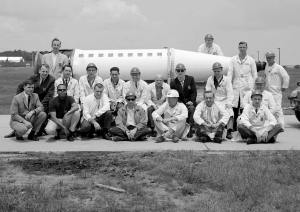
Weightless Analysis Sounding Probe Launch Team at Wallops Island
The team from the National Aeronautics and Space Administration (NASA) Lewis Research Center poses in front of the Weightless Analysis Sounding Probe [WASP] at Wallops Island, Virginia. The WASP was a two-stage sounding rocket designed by the Lewis Spacecraft Technology Division’s Harold Gold to examine the behavior of liquid hydrogen in microgravity. The Lewis launch team is seen here prior to the June 7, 1966 successful launch off of Wallops Island. Gold is second from the right in the second row in this photograph. Lewis had demonstrated the effectiveness of liquid hydrogen as a propellant in the late 1950s and convinced NASA management that liquid hydrogen should be used in its upper stage rockets. In 1962, the center took over the management of Centaur, the first liquid hydrogen rocket, and NASA was developing a hydrogen-fueled upper stage for Saturn. NASA Lewis undertook a wide-ranging effort to determine the best ways of handling the propellant. They studied its pumping, storage tanks, sloshing, and its behavior in microgravity. The WASP rocket would carry a transparent scale model of the Saturn-II fuel tank and television cameras to film the behavior of the propellant during flight. The WASP was tested in the Space Power Chambers’ high altitude tank prior to its launch. The propellant was purposely sloshed by a thruster on the side of the tank during the launch. The tank contained a baffle ring that quickly settled the sloshing fuel. The 862-pound rocket reached an altitude of 250,000 feet before freefalling back to Earth. The almost seven minutes of microgravity during freefall provided researchers with enough data to launch the first orbital Saturn IB one month later.
- X




























